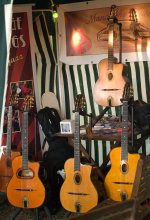BR Ukuleles
Well-known member
I've done 6 of these tenor soundboards the last few days, so thought I might shoot a little video to help demonstrate the process.
I always install the tiles first and let the glue dry. Then rout the purfling lines afterwards. Makes for a far cleaner and easier install when you have something this complicated.
What you don't see is that once they are all in place I flood the area with hot hide glue and work it in by running a veneer hammer over the area. Wipe up excess glue and let dry. Finally cut out sound hole.
I always install the tiles first and let the glue dry. Then rout the purfling lines afterwards. Makes for a far cleaner and easier install when you have something this complicated.
What you don't see is that once they are all in place I flood the area with hot hide glue and work it in by running a veneer hammer over the area. Wipe up excess glue and let dry. Finally cut out sound hole.


